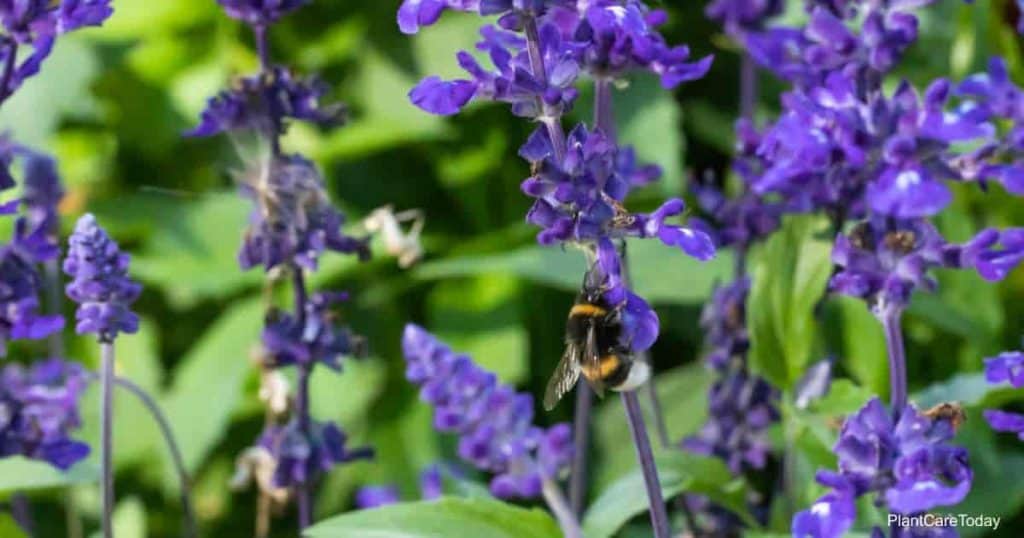Used in medicinal remedies and culinary delights, the Salvia Officinalis (sal-vee-uh oh-fiss-ih-NAH-liss) is a versatile and beautiful plant. It is a perennial evergreen shrub with woody stems, gray-colored leaves, and conical-shaped purple flowers.
The Salvia plant originated in the Mediterranean region, but now is cultivated throughout the world. Though used in cooking and health treatments for centuries, it is also commonly used in gardens for decorative purposes.

Salvia Officinalis is part of the unique category of flowering plants of the Lamiaceae or Labiatae family. Classified as a member of the mint family, this salvia is also part of the deadnettle and sage subfamilies and is also known by names like:
- Common sage
- Culinary sage
- Garden sage
- Golden Sage
- Kitchen sage
Size and Growth
A sage known for its hardiness, the Salvia Officinalis is a moderately sized shrub. You can expect a moderate growth rate that tops out at approximately 2′ feet tall and 2′ to 3′ feet wide.
The development of the plant will feature stems that sprout green leaves. The sage leaves are soft to the touch and striped with yellow margins. Their different patterns add to the plant’s appearance.
Purple Sage Flowering and Fragrance
The Salvia Officinalis shows consistency. In most cases, blooms start in early spring, with full flowers coming in late spring and early summer.
Though they usually are lavender in color, they can also grow in pink, white, and blue flower hues.
As one would expect, a plant used in cooking has a unique set of smells. This sage has a piney scent among its stems, yet its flowers tend to have a deeper spicy aroma.
Its collection of smells also make this plant a favorite in essential oils and other fragrances.
Light and Temperature
In line with its hardy nature, it comes as no surprise that Salvia Officinalis is a plant that does well in direct sunlight. It can tolerate a slight amount of shade, but the sunnier, the better.
Its Mediterranean origin makes sunny seaside climates with moderate moisture the perfect environment.
The Salvia Officinalis, like all sages, tends to grow best when temperatures are consistent. Climates with temperature ranges between 60° to 75° degrees Fahrenheit have the best success.
Yet, it can survive temperature extremes and keep perennial consistency even if temperatures drop below freezing.
Watering and Feeding
Watering for this sage is low, with extra watering required only during drought times, a mere 1″ inch every seven days.
There is no additional fertilization required. The only recommendation is to remove dead flowers and let them remain at the plant’s base for extra nutrients.
Soil and Transplanting
Damp soil can be the enemy of salvia. Too much moisture causes root rot and will be hostile to your plant. Use rocky soil with excellent drainage as pooling water can cause a problem. Salvia enjoys slightly alkaline soil.
Take care when transplanting and only do so in temperate climates. Extreme cold or heat can cause significant problems in salvia establishing its roots.
Dig the hole before transplanting as too long an exposure to open-air can damage its roots.
Grooming and Maintenance
Though it does not need a lot of stem trimming, its flowers need some grooming. It is important to deadhead spent flowers during the season, encouraging new growth.
As the sage ages, it will get woody stems that are safe to trim.
Experts recommend cutting the stems back to 1″ to 2″ inches over the soil after the first deep frost if you live in colder climates. The new branches will begin to grow once again as you move into late winter and early spring.
More Salvia Varieties for the Landscape
- Salvia Nemorosa – Woodland Sage
- Salvia Mohavensis – Mojave Sage
- Salvia Splendens – Scarlet Sage Flower
How to Propagate Salvia Officinalis
For those who want to spread your sage garden, propagating the Salvia Officinalis is simple. When pruning the dead flowers, let them remain at the base. Their seeds will spread naturally or by feeding birds.
If you want to have a broader range of your plant, distribute salvia cuttings throughout your garden. You will find more plants in the spring or late fall.
Sometimes salvia will self propagate, creating seedlings ready for transplanting throughout your yard.
Pest and Diseases
One of the great benefits of the sage is that it has few pest enemies. The most common are Aphis passeriniana, chrysolina, and americana larvae.
A well-maintained plant, properly watered, and correctly pruned plant will keep these pests at bay. Any infestation treatment is easy.
Diseases cause most sage problems. Bacterial diseases like crown gall and mint rust deform and discolor leaves and stems. Yet, these are usually caused by improper watering and easily treated.
A Great Addition to Your Herb Garden
Salvia Officinalis, in many ways, is the perfect plant. It checks off every box on the list.
It is easy to maintain, fragrant, great for cooking, hardy, propagatable, and beautiful. For the beginning gardener or the seasoned botanist, this sage is a fantastic addition to any garden.
